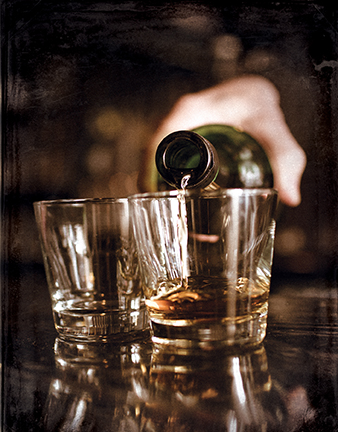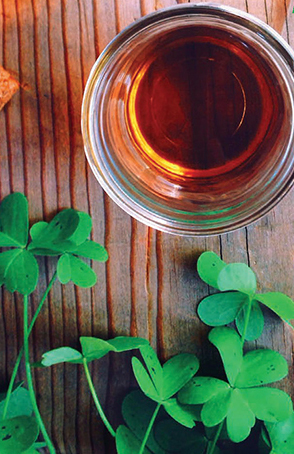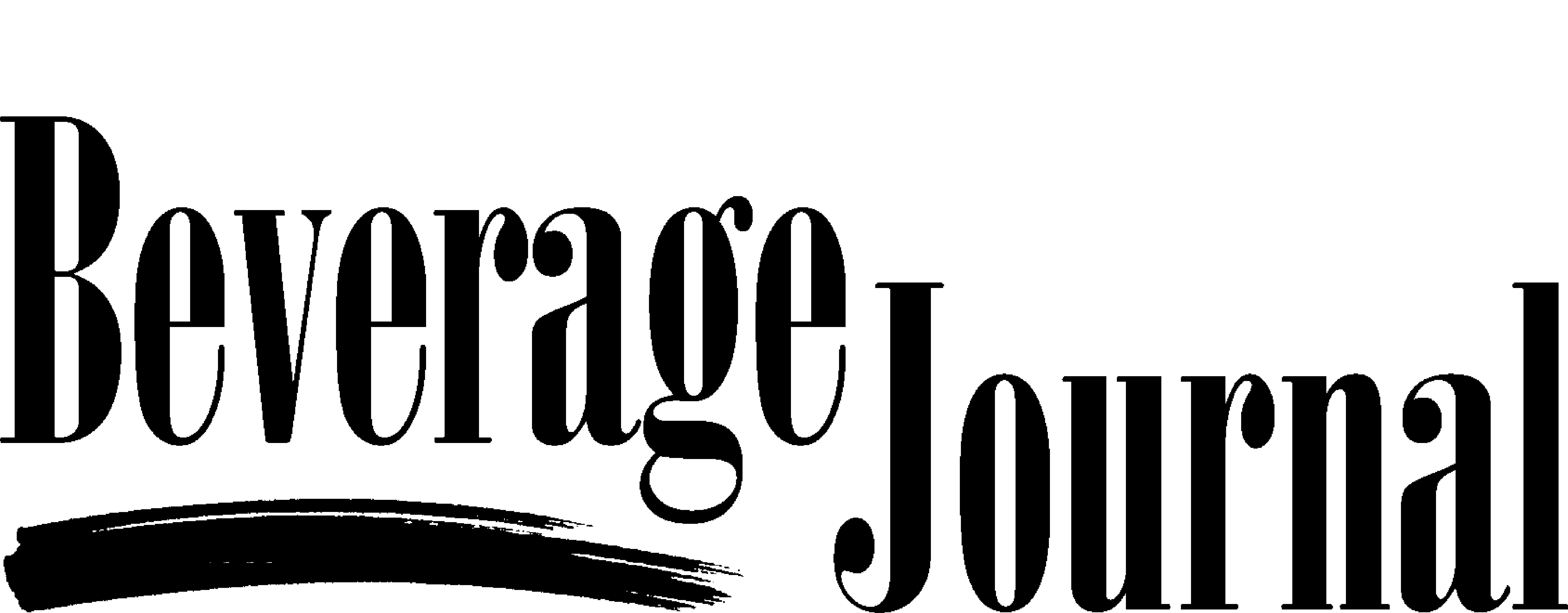Trending Articles ...
Whiskey’s Brightest Spot: The Irish Surge is Just Beginning

If you’re looking for bright spots in the world of Irish whiskey, it’s hard not to find them. The question is where to start.
For example, ground has recently been broken in County Carlow for the new 25 million pound Walsh Whiskey Distillery, a venture backed by the Italian makers of Disaronno Liqueur. Meanwhile to the northwest, William Grant & Sons, owner of Tullamore D.E.W., will fire up the stills next fall at their new distillery, the first in a generation for the brand. Those two are just part of the unprecedented Irish whiskey distillery boomlet, to be followed by other new facilities including one at a former Diageo brewery site in Dundalk and another right in Dublin.
All this, of course, complements the enormous expansion of the new Midleton Distillery, headquarters of Irish Distillers’ broad portfolio of whiskies, including world leader Jameson. Beam Global’s assimilation of Kilbeggan and other brands formerly owned by the Cooley Distillery continues apace. And among whiskey aficionados, there’s been great enthusiasm for such hard-to-get brands as Greenspot, a legendary Irish whiskey that even competitors have been known to pack when returning from Ireland, and 21 Year Old Red Breast Pot Still Whiskey.
These changes are a result of Irish whiskey’s role as the fastest-growing whiskey in the world over the last five years, leaping from 4.4 million cases to 6.5 million since 2008, with analysts expecting that growth to hit 12 million cases in the next five years. In 2012, the last full year for which numbers are available, Irish grew 22.5% in the U.S., according to the Distilled Spirits Council of the United States, with super-premium brands and extensions up an astonishing 86%. The U.S. is the largest and fastest growing market for Irish whiskey with sales of 2.2 million cases in 2012 and is now a larger category than single malt Scotch here.
Rapid Market Change
Quite a difference from about 20 years ago, when every major and most minor brands were owned by one company. Yet there’s still a long way to go before Irish gets anywhere near its pre-Prohibition standing as THE imported whiskey in the U.S.
“Irish whiskey is still in its infancy,” says Pernod Ricard USA VP Irish & North American Whiskey Paul DiVito. “It’s one of the smallest categories by volume and even though there’s been double digit growth for well over a decade we expect the category to double over the next five years.”
The changes in the Irish business and the entrance of deep-pocketed rivals like Beam and Grant is welcomed, he says, to spur on further growth. “In ten years or so, all these new distilleries will be producing some amazing whiskies and we’re going to give Scotch a run for their money a real changing of the guard,” says DiVito. To expand the category, he and other marketers actually encourage retailers even to take on competitive brands in order to broaden the selection for curious consumers.
DiVito points out that traditional markets like New York and California continue to thrive, with states including Texas and Florida presenting huge opportunities for the category.
“Whiskey is as popular across all regions of the U.S. as it has ever been and the whiskey consumer is becoming more diverse—younger, female and multicultural,” says Yvonne Briese, VP North American and Irish Whiskies for Diageo. “These new whiskey consumers are more educated and savvier. They seek high quality, crafted products with great stories.”
Adding New Dimensions
Brand reps see lots of cause for optimism. Irish whiskey drinkers tend to skew younger than with other whiskies, and are showing an openness to exploration beyond standard entry-level blended Irish whiskies. Even the burgeoning flavored whiskey market shows promise: Pernod Ricard, owner of Irish Distillers, recently relaunched Paddy in the U.S. as an entry level Irish at a lower price point than Jameson and added flavors Bee’s Sting and Devil’s Apple. Ninety days into the launch, the flavors are “enjoying tremendous success,” says DiVito.
That success is no surprise to suppliers of Bushmills, who launched the first flavored Irish in the U.S. a few years ago. “Bushmills Irish Honey has opened up more opportunities with consumers through creating a more approachable whiskey,” says Briese. “Our research shows that flavored whiskey is recruiting consumers from other spirit categories. It is also expanding occasions for our current whiskey drinkers.”
Taking an even bolder approach, M.S. Walker is launching Kennedy Irish, an innovative line of an “Original” whiskey plus four 70-proof infusions: Limed, Honeyed, Spiced and Chillied. Handcrafted in West Cork, the line will sell at a competitive $22 price point.
Diversity & Tradition
Another Pernod Ricard brand, Powers, has been growing over the past ten years without much support, but now it has been reformulated, repackaged and expanded, and expectations are up, as is pricing. With a larger proportion than Jameson of Single Pot Still whiskey in the blend, Powers has garnered fans among Irish drinkers looking for more spice and fuller flavors. Now at the original 42.3% ABV and non-chill filtered, the brand is being positioned as the next place to go for explorers within the category, says DiVito. In addition, there’s a new Single Pot Still expression, Powers Signature Release, joining the ultra-premium Powers John’s Lane, released last March.
That sense of exploration among consumers of Irish has brought most brands to expanded offerings. “Like a lot of whiskey drinkers, a portion of Irish drinkers are becoming explorers, and we find they stay with Irish but want other expressions. Within the category, we’re making those expressions more available as we can, all the way up to Redbreast,” he says. For instance, Pernod now offers four iterations of pure pot still whiskey—Powers John Lane, Midleton, Redbreast and Green Spot. Other suppliers have accentuated single malt offerings, while recently, Grant has offered a variant called Tullamore Phoenix, a 55% ABV limited release.
While a broadening range of distinctions mark the Irish category’s current offerings, from a packaging and image standpoint suppliers have remained mostly traditional, with many brands directly evoking authentic Irish culture and family names. One of the most successful ongoing examples is Michael Collins, named for the legendary hero synonymous with Irish independence. The lightly peated Michael Collins 10 Year Old Single Malt and the recently repackaged Michael Collins Blended Irish Whiskey, imported by Sidney Frank Company, are both available nationwide.
Concannon has done well since the 2012 U.S. launch, presenting both a four-generation-family connection to Ireland and a novel twist—aging in Concannon Petite Sirah barrels. Brand new (and naturally just in time for St. Patrick’s Day 2014), the Donegal Estates brand, from Star Industries, is well positioned with a bourbon-cask-aged profile and classical label.
Speaking of classics, and also launching this month, here’s an interesting new variation on a beloved theme: Irish Mist, the honeyed whiskey liqueur dating back to 1947, has engineered a sort of reverse line extension, releasing a straight Irish Whiskey. The only global brand to have the word “Irish” in its name, Irish Mist Whiskey plays off the flavorful base recipe of the original liqueur. A blend of four-year-old whiskies that have been triple-distilled and aged in American oak, the whiskey delivers aromas of raisins, vanilla and soft spice, with hints on honey and toffee on the palate.
Keeping the Flames Burning
Sensing they have a proverbial tiger by the tail, suppliers and marketers are ramping up promotions. In order to spur the sense of discovery about their brand, Tullamore has hired a national brand ambassador and six others for local markets. “Whiskey requires more education for consumers and the trade to understand the differences and the back stories of the brands,” says Reilly. “True advocacy can’t come from hoping from city to city. The grassroots approach bears fruit over time, having ambassadors who understand the local markets working there.”
Building awareness that Irish is a family of whiskies—blended, pot still, single malt, cask strength, even peated—is the goal of Kieran Folliard, the founder of 2 Gingers Whiskey and Beam’s Irish brand ambassador in the U.S. The 2 Gingers brand has become a phenomenon since Folliard, a former Minnesapolis pub owner via Ireland, launched it in 2011. Bought by Beam, the brand is what Folliard calls their portfolio’s Trojan horse, with it and Kilbeggan showing growth rates above 60% last year. 2 Gingers is in the midst of a national roll-out and Beam’s focus is being rewarded as the brand has surged to second-most popular Irish in some Midwestern states, he says, a result of focus on Irish pubs, sports bars and high volume operations where he targets non-whiskey drinkers for conversion before stepping them up to their other brands—peated Connemara, grain Greenore and single malt Tyrconnell.
It’s a model other Irish whiskey companies are emulating. “Most people are entering the category through standard blends and are doing so due to the smooth and sweet taste they deliver,” says Jack Teeling, founder of the Teeling Whiskey Co., now imported by Infinium Spirits. “We think there is an opportunity to build on this taste profile by producing more flavorsome blended Irish whiskies and also allowing them to move up the flavor ladder into the world of Irish single grain and single malts.” Teeling expects to launch in the U.S. this spring and to be distilling in a new facility in Dublin by the end of the year.
Those new distilleries are being built with an acute awareness of the changes in the U.S. whiskey-making and drinking market. “We position ourselves as the craft Irish whiskey producer, creating super-premium whiskeys,” says Conor Chase, brand manager of Palm Bay-imported The Irishman, which has among variations a Founder’s Reserve Pot Still Blend, made with 70% single malt and 30% pot still whiskey, a style of Irish more common pre-Prohibition. “Today in the USA there is a huge movement towards craft products, which indicates a clear demand for premium and quality products. This has reopened the door to traditional and different styles of Irish whiskeys, which are currently less common there,” says Chase.

Irish Blending Basics
Like with Scotch whisky, the biggest selling Irish whiskies today are blended, a mix that usually includes grain whiskey with some pot still whiskey or single malt whiskey added in varying percentages. At least one brand—Tullamore D.E.W.—is made up of all three styles. But on the growing US market for Irish, a multitude of types —pot still, single malt, grain, blended, cask strength—are being offered.
Most blended whiskies are predominantly grain with some 20-30% malted whiskey or pot still whiskey added in. Grain whiskey is just that—whiskey made from wheat or corn or another grain, usually in a column still. It can be made using malted and unmalted barley as well, although that is considered uncommon. Single Pot Still Irish whiskey is today a mix of malted and unmalted barley distilled in copper pots, a style said to have been created as a way around British taxes on malt. Once oats and rye might have been in the mix as well. Single malt, like with Scotch, is a whiskey that comes from only one distillery and not mixed with grain or pot still whiskies.

